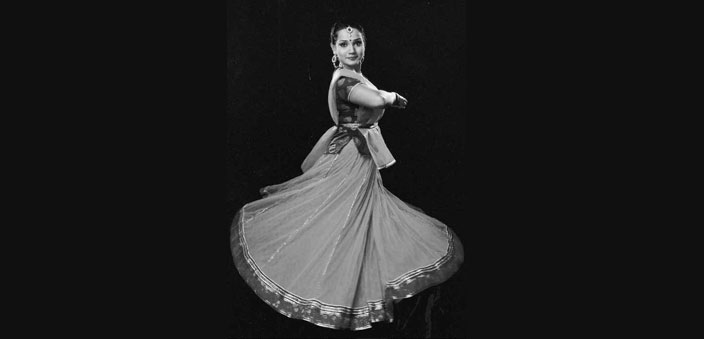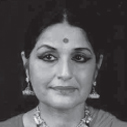Kathak, the classical dance style from north India conjures up visions of scintillating footwork and lightning chakkars that is the pirouettes. The word Kathak is derived from the word Katha that is story. In ancient times the wandering bards used to go from village to village and recite chiefly the two epics Ramayana and Mahabharata. In order to make their art more attractive they started adding song and dance into it. Sometimes during the Muslim invasion, the Persian influence came into the art brought in by the dancing girls who were called tawaifs, and as such a very spiritual dance slowly started turning into a court presentation. Today what we see in Kathak is a blend of these two streams. It has got the courtly atmosphere at the same time it is highly spiritual.
A practice which started in the earlier centuries of the Christian era and was a simple form of expressional dance evolved into a distinct style in the l5th and 16th centuries with the popularisation of the Radha-Krishna legend and the emergence of madhura bhakti – special manifestation of Vaishnavism. This emergence of madhura bhakti gave rise to an operatic play called Rasa-Leela which developed mainly in the Braj area associated with Krishna’s early life.This rasa-leela gradually developed into a well established folk theatre which had a harmonious blend of song, storytelling, acting and dancing.
The patrons of Kathak
After Muslim invasion, the dance resulted in two different streams – one relying on the Hindu patronage in the court of Jaipur and the other with the backing of the Muslim courts of Delhi, Agra and Lucknow. Yet in both these streams, Kathak came to be treated as a solo art where the touchstone of excellence was the virtuosity of the solo dancers, specially their command over laykari of footwork.
Specially in the Jaipurstream the emphasis almost totally shifted on nritta making the style a vehicle for mere mechanical display. While the Muslim patrons had no overpowering preference for mere rhythmical pyrotechnique; they fancied an art that was full of human sentiments and worldly situations. Thus their brand of Kathak laid stress on nritya full of bhava. Thus this Kathak turned out to be more graceful and sensuous.
This stream came to be recognised as the Lucknow Gharana and it came into existence in the time of Wajid Ali Shah. The chief architect was one Thakur Prasad whose two sons Kalka and Binda Din perfected it. Wajid Ali Shah’s contribution to the development of Kathak is noteworthy. He was an accomplished dancer and musician and good poet in Hindi and Urdu. He spent lavishly on dance and music, much to the disgust of the British of the East India Company who dethroned him and exiled him to Calcutta (now Kolkata) and annexed his principality Oudh. Till his death he lavished his pension on Kathak and music.
Another noteworthy patron of Kathak was Raja Chakradhar of Raigarh in Madhya Pradesh. He encouraged both the gharanas – Lucknow as well as Jaipur. He too was removed by the British for his great love and lavish spending on Kathak.
As has been already noted the great votaries of Kathak were all men. Women also had a place in Kathak, although quite dubious, their contribution in the early part of development was not noteworthy. These women divested their dance of any dignity and came to be termed as women of easy virtue. Toda – the true test of a dancer’s dexterity and virtuosity Kathak originally had only two instruments – the sarangi and the tabla. To large extent the Kathak technique is nritta-oriented and so concerns itself with rhythm and timing. Therefore the footwork is the predominant element of Kathak. The dancer ties atleast 100 ghunghroos on each foot and cajoles myriad rhythmic patterns, nuances and tonal variations by the footwork which is called tatkar. It is amazing that a versatile dancer can sound only one ghunghroo out of the full complement of 100 in the most melodious manner. Yet a complete unit of nritta has not only scintillating footwork but also an accompanying, harmonious use of the entire body. Such a piece is called a toda which has several varieties. This exhibition of todas is the true test of a Kathak dancer’s dexterity and virtuosity.
Another noteworthy facet of the Kathak nritta are the chakkar or the pirouette or spin which are performed at a lightning speed and which end in a superbly balanced flourish and pose.
The nritya in Kathak has two types of Gat: Gat-Nikas and Gat Bhav. Out of these the Gat-Bhav is full blown nritya depicting a theme, a story or an episode. But it must be noted here that in comparison to the other more developed dance styles, Kathak has very few hastas. Thus for emotive passages the attitude of the body and the different stances it adopts to depict an idea are used in the most effective manner. For example the Ghunghat Gat which is supposed to depict pulling of the ghunghat (veil) over the face by a woman the dancer will not do just one interpretative action but will show different ways in which the ghunghat is pulled in different situations and moods.
The next items for nritya interpretation are the Thumri and Bhajan which are danced to fulI-fledged songs. Here too there are practically no hastas and the role of the hands is only secondary. Even the mukhaja abhinaya is very subtle and suggestive. Other items in this genre are the Dadra and the Gazal which are types of songs to which bhav is done.
Since originally Kathak was a religious dance, there were religious songs like dhrupads, keertans, dhamars, horis, pads which were utilised for depiction of nritya.
In the recent times two new items have been added – the Vandana is a propitiatory item done at the beginning of the recital and is in praise of a deity while the Ashtapadis are taken from poet Jayadeva’s Geeta Govind.


